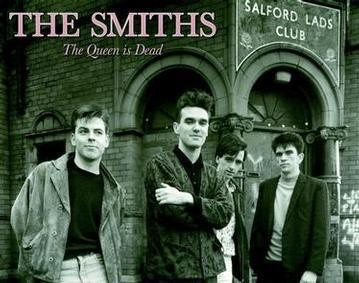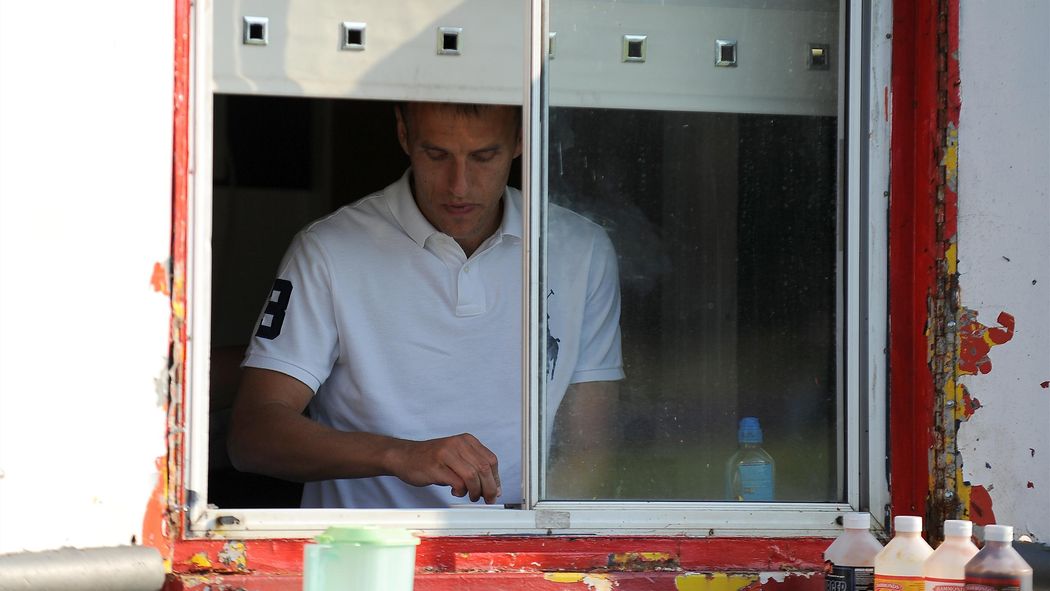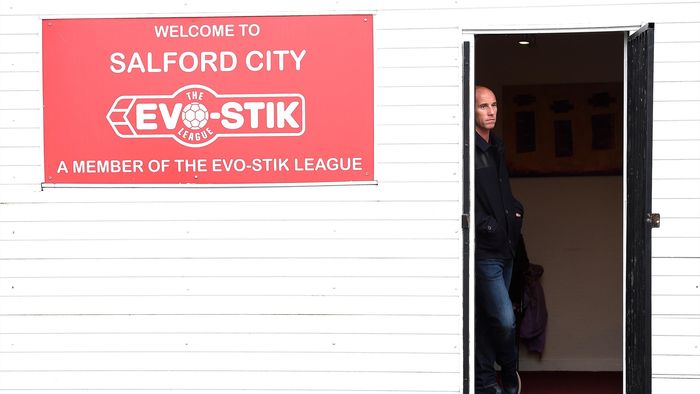Andy Mitten says the Class of 92's pet project, Salford City, are ready to take centre stage in the FA Cup.
It’s November 1991 in the Drayton Park, a pub near Arsenal known to away fans. The bar is full of travelling Manchester United fans ahead of a 6-2 League Cup victory when a chant goes up: “S-A-L-F-O-R-D, Salford Reds and MUFC!”
United have long drawn members of their hardcore from Salford,
the city co-joined with Manchester. The border, for miles, is the banks
of the River Irwell and the Manchester Ship Canal.
Salford comes so close to Manchester that it forms part of Manchester City
centre. United’s players spend every night before a home game in
Salford’s Lowry Hotel. The much-vaunted BBC move north to Manchester was
actually to Salford, the largest metropolitan area without a
professional football team in England. That’s 233,000 people (333,000 in
1931 when the docks were thriving), the majority of whom will call
Manchester United their club.
George Best
used to drink with friends in the Brown Bull pub near Salford Crescent
station. Manchester United’s hooligans used to meet up in Salford. The
Cliff training ground is in Lower Broughton, as was United’s secondary
training ground of Littleton Road. United considered expanding this site
before the move to Carrington in 2000, but decided against it.
Commenting on the Littleton Road site in 1995, Sir Alex Ferguson
said: “It’s very exposed and the wind howls through the place. It could
be a good training ground but it would cost a lot of money.” Money the
club decided was better spent developing Carrington.
The southern end of Salford comes to within 200 metres of Old Trafford, a traditional red heartland.
Some of United’s greatest ever players are Salford boys. Giggs
is Salford (since six), Scholes was born in Salford, Stan Pearson too,
while Eddie Colman
– the winger known as snakehips and who died at Munich - is Salford.
One of the city’s many tower blocks takes his name. Or, more
specifically, Colman is from Ordsall, an estate of 6,000 largely
working-class residents sealed off by giant roads and the ship canal.

Ordsall is where you’ll find Salford Lads club, famous for its
appearance on the iconic cover of The Smiths’ ‘The Queen is Dead’ album.
The club opened its doors on the night of February 6 1958 for locals to
mourn, especially for former member Colman, who died aged 21. He is
buried in nearby Weaste cemetery, his grave marked by a black headstone.
Former defender Billy Garton was born there. When he was five, a
lecturer at nearby Salford University made a film of the living
conditions in Ordsall. In two parts, it was entitled ‘Life in the Slums’
and ‘Bloody Slums’. Salford, one of the reddest areas of Greater
Manchester, is the subject of the Ewan MacColl’s song ‘Dirty Old Town’.
Despite the poverty, Garton is convinced that the bonds and
values forged growing up in Ordsall were vital in later life.
“A lot of great people went onto better things from Ordsall
because they had good values,” he says. “Take my best mate Les. He is
two years older than me and when he was 16 he used to pay for me because
I had no money and he had a job. He’d die for me - you get a bond like
that when you come from a place like Ordsall. Where I live now in
California is like paradise on earth, but there’s little loyalty.
“People want to be an acquaintance but it’d tough to get close
to people. Where I grew up my mates stuck together through and thin. If
you were ever on your arse mates would help you out, either financially
or morally. That did and still means a lot to me. Mates were like family
and any scallies who just looked after themselves ended up with no
mates.”
Albert Finney was Salfordian, Shelagh Delaney, Sir Ben Kingsley,
Christopher Eccleston, Emmeline Pankhurst, George Bradshaw, James
Joule, Sir John Moores, Ken Wolstenholme, Shaun Ryder, Tim Burgess,
Anthony H Wilson, Robert
Powell, William Webb Ellis and many more. Tony Warren, creator of
Coronation Street, which is set around a fictional Salford Street, hails
from there.
At the northern end of Salford, beyond the Cliff training ground
which is still used by United, past the Castle Irwell racecourse –
‘Manchester’s racecourse’ - which closed in 1963 and just off Littleton
Road where United also used to train, is Moor Lane, the home of Salford
City – the Ammies, as they used to be Salford Amateurs.
The tree-lined non-league football ground stands on land which
formed the Kersal Moor racecourse between 1681 and 1847. Races there
used to attract up to crowds of 100,000 including (according to local
newspaper reports) “Unlicensed sutlers (vendors) and hucksters,
peddlers, prostitutes and thieves” around the Whitsuntide horse races.
Nicky Butt watches the teams warm up before Manchester United U21's game with Salford City. - PA Photos
A local pub ‘The Kersal’, was demolished in 2004, the horse on
the pub sign a reminder that for over 150 years Manchester’s main
racecourse lay opposite.
At 4.5 miles, Moor Lane is the fourth closest football ground to
Old Trafford after Maine Road FC in Chorlton, Trafford FC in Urmston
and Manchester City FC in Bradford, East Manchester.
It has also been a site for organised sport for over 320 years,
longer than anywhere else in what’s now Greater Manchester. Moor Lane
has staged cricket, tennis, archery, athletics and rugby (Salford is
better known for its top-flight rugby league team than any football
club) before Salford City moved to Moor Lane in 1976. Until their
takeover last year, the Ammies attracted gates of 150, most paying the
£7 admission fee (though they had 3,000 for a cup tie in 1981) in
England’s eighth tier.
Moor Lane boasts two small stands (one is little more than a bus
stop), grass banks and the capacity is limited to around 1,500. It has
long been a pleasure to visit. Before the 2014 takeover, people behind
Salford City, like chairman Darren Quick and president Dave Russell,
loved their club and love their team. Many are United fans; people who
felt that they are putting something back into the community – and not
just by providing excellent pie, peas and gravy in their clubhouse.
In 2014, the Class of ’92 took over in a highly publicised move
which has been covered by a BBC One documentary which aired this week. Gary Neville, Ryan Giggs, Nicky Butt, Phillip Neville and Paul Scholes are partnered by Peter Lim, a Singaporean businessman who also owns CF Valencia.
Takeovers rightly attract suspicion from fans sceptical of the
motives. Outside the Premier League, football doesn’t make money, but
clubs are taken over for a variety of reasons. It might be the local
businessman putting something back into the community or someone looking
for profile, to see his ego massaged.
Salford City is unique. The Class of ’92 don’t need profile and,
in part because of who they are, Salford City has so far run at a
profit. A friendly game against the Class of ’92 attracted a five-figure
crowd and when you’ve got famous former footballers, sponsorship is
easier to attract. Revenue from media helps, too.
Gates have surged from 150 to almost 500 at home – where Salford
have won only one of seven league games. They’ve won all eight away
matches and sit fourth, with games in hand, in England’s seventh tier.
Salford is full of United fans who, for many reasons, don't go
to Old Trafford. Salford City – and the many semi-professional sides
around the non-league football hotbed of Manchester – are an
alternative. FC United, for example, was set up to provide affordable
football at a time when ticket prices were rising season on season.
There has not been a price rise at Old Trafford for five years
and the current intelligence points towards price reductions rather than
rises. But United, who have to fund the wages of some of football’s
best players, will never be anywhere near as cheap as Salford. They
appeal to different markets with a small crossover. Any locals who can’t
afford to watch Premier League football can buy a Salford season ticket
for £50.
The Class of ’92 lads see Salford as a release, a hobby, a
passion. They go and watch live football home and away with their mates –
each other. They stand against the crush barrier and they love it. It’s
not a plaything and they realise they have responsibility. Non-league
football is littered with owners who’ve pulled their money and left
clubs in limbo. Would it be worth the criticism if the Class of ’92 did
the same? Not that they need to put money in at the moment.
Contrary to the rumours from green-eyed monsters, Salford’s top
paid player is on £400 per week. Most of their players are on less than
£200.
They’ve reached the FA Cup first round and will play Notts
County tonight. They’re staging the game at Moor Lane, which, while
spruced up, has only very basic facilities. There’s no segregation,
though it does have space for development and that will be needed if
Salford get promoted, but for now the attention is on tonight’s first
ever FA Cup first-round game against the world’s oldest professional
club.



Blogger Comment
Facebook Comment